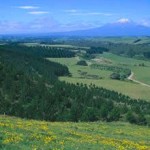
New results from an investigation into Antarctica’s potential contribution to sea level rise are reported on Sunday, 20 June, by scientists from the British Antarctic Survey (BAS), Lamont-Doherty Earth Observatory (LDEO) and the National Oceanography Centre in the journal Nature Geoscience.
Thinning ice in West Antarctica is currently contributing a substantial and increasing volume to global sea level rise, and scientists have identified Pine Island Glacier (PIG) as a major source. As part of a series of investigations to better understand the impact of melting ice on sea level, an exciting new discovery has been made in the Amundsen Sea. Using Autosub (an autonomous underwater vehicle) to dive deep and travel far beneath the PIG’s floating ice shelf, scientists working on the research vessel NB Palmer made ocean and sea-floor measurements revealing a submarine ridge rising 300m above the sea floor.
Pine Island Glacier was once scraping across this underwater ridge, which slowed its flow. However, in recent decades, it has thinned and disconnected from the ridge, allowing the glacier to move ice more rapidly from the land into the sea. This also permitted relatively warm seawater to flow over the ridge and into a widening inner cavity, more than doubling the ice shelf area exposed to the corrosive ocean. As the melting increases, the glacier accelerates, drawing down the inland ice and moving its vulnerable grounding line (where the ice begins to float) deeper into the interior of the West Antarctic Ice Sheet.
Lead author Dr. Adrian Jenkins of British Antarctic Survey said, “The discovery of the ridge has raised new questions about whether the current loss of ice from Pine Island Glacier is caused by recent climate change or is a continuation of a longer-term process that began when the glacier disconnected from the ridge.”
“We do not know what kick-started the initial retreat from the ridge, but we do know that it started some time prior to 1970. Since detailed observations of Pine Island Glacier only began in the 1990s, we now need to use other techniques such as ice core analysis and computer modeling to look much further into the glacier’s history in order to understand if what we see now is part of a long term trend of ice sheet contraction. This work is vital for evaluating the risk of potential wide-spread collapse of West Antarctic glaciers.”
Co-author Stan Jacobs adds, “Since our first measurements in the Amundsen Sea, estimates of Antarctica’s recent contributions to sea level rise have changed from near-zero to significant and increasing. Now finding that the PIG’s grounding line has recently retreated more than 30 km from a shallow ridge into deeper water, where it is pursued by a warming ocean, only adds to our concern that this region is indeed the ‘weak underbelly’ (T. Hughes, 1981) of the West Antarctic Ice Sheet. Increased melting of continental ice also appears to be the primary cause of persistent ocean freshening and other impacts, both locally and downstream in the Ross Sea.”
This research is funded by the U.S. National Science Foundation (NSF) and UK Natural Environment Research Council (NERC).
Source: BAS.
Notes:
British Antarctic Survey (BAS), a component of the Natural Environment Research Council (NERC), delivers world-leading inter-disciplinary research in the Polar Regions. Its skilled science and support staff based in Cambridge, Antarctica and the Arctic, work together to deliver research that underpins a productive economy and contributes to a sustainable world. Its numerous national and international collaborations, leadership role in Antarctic affairs and excellent infrastructure help ensure that the UK maintains a world leading position. BAS has over 450 staff and operates five research stations, two Royal Research Ships and five aircraft in and around Antarctica. Visit www.antarctica.ac.uk for more information.
Lamont-Doherty Earth Observatory (LDEO), a member of Columbia University’s Earth Institute, is one of the world’s leading research centres seeking fundamental knowledge about the origin, evolution and future of the natural world. More than 300 research scientists study the planet from its deepest interior to the outer reaches of its atmosphere, on every continent and in every ocean. From global climate change to earthquakes, volcanoes, non-renewable resources, environmental hazards and beyond, Observatory scientists provide a rational basis for the difficult choices facing humankind in the planet‘s stewardship. Visit www.ldeo.columbia.edu for more information.
National Oceanography Centre (NOC) is a new, national research organization that went live on 1 April 2010. NOC will work in partnership with the UK marine research community to deliver integrated marine science and technology from the coast to the deep ocean.
NOC brings together into a single institution NERC-managed activity at the National Oceanography Centre, Southampton, and the Proudman Oceanographic Laboratory in Liverpool. NOC will work in close partnership with the wider marine science community to create the integrated research capability needed to tackle the big environmental issues facing the world. Research priorities will include the oceans’ role in climate change, sea-level change and the future of the Arctic Ocean. Please visit www.noc.soton.ac.uk for more information.
The NERC royal research ships RRS James Cook and RRS Discovery are based at NOC in Southampton, as is the National Marine Equipment Pool, which includes Autosub and Isis, two of the world’s deepest-diving research vehicles.















